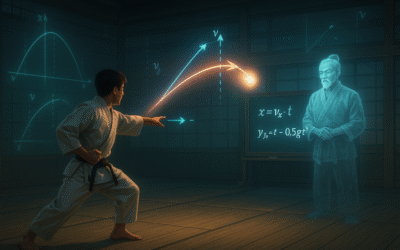🥋 Newton’s Third Law – White to Black Belt Mastery
“For every action, there is an equal and opposite reaction.”
White Belt Level – Key Concept
Newton’s Third Law says that forces always come in pairs.
If object A pushes on object B, then object B pushes back on object A with equal strength but opposite direction.
In simple words: Action = Reaction.
🎮 Explore: PhET Simulations – Forces and Motion: Basics
Core Principles
- Forces always come in pairs (action and reaction).
- The two forces are equal in size but opposite in direction.
- They act on different objects (not on the same object).
- Motion depends on the mass of each object (Newton’s Second Law still applies).
📖 Learn more: OpenStax University Physics, Ch. 4
Key Equations (SI Units)
- Action Force: F⃗_AB (force of A on B)
- Reaction Force: F⃗_BA (force of B on A)
- Rule: F⃗_AB = –F⃗_BA
🔎 Reference: HyperPhysics – Newton’s Third Law
Common Mistakes and Pitfalls
- Thinking forces cancel each other out (they act on different objects, so they don’t).
- Forgetting to apply Newton’s Second Law to each object separately.
- Mixing up action and reaction pairs (they must always be the same type of force: contact-contact, gravity-gravity, etc.).
Sensei’s Shortcuts
🤜 Push-Back Test: If you feel a push when you push on something, that’s the reaction force. Try it with a wall or desk.
Worked Example – Step by Step (White Belt)
Problem: A swimmer pushes the water backward with a force of 120 N. What force does the water exert on the swimmer?
Step 1. Formula:
F⃗_AB = –F⃗_BA
Step 2. Substitution:
Swimmer on water = 120 N backward
Water on swimmer = 120 N forward
Step 3. Final Answer:
The water pushes forward on the swimmer with 120 N.
Practice Drill (White Belt)
- A horse pulls on a cart with 500 N. How much force does the cart pull on the horse?
Answer: 500 N (opposite direction) - You push a wall with 50 N. What force does the wall push back with?
Answer: 50 N (opposite direction)
Yellow Belt Extension – Deeper Skills
Problem: A 60.0 kg person jumps off a boat by pushing backward on it with 300 N. What happens to the boat (mass 240 kg)?
Solution Outline:
- Action: person pushes boat = 300 N backward
- Reaction: boat pushes person = 300 N forward
- Person’s acceleration: a = F/m = 300 / 60.0 = 5.00 m/s² forward
- Boat’s acceleration: a = F/m = 300 / 240 = 1.25 m/s² backward
Final Answer:
Person: 5.00 m/s² forward
Boat: 1.25 m/s² backward
🎮 Try this in the Motion tab of PhET Forces and Motion: Basics.
📖 Extra reading: Khan Academy – Newton’s Third Law
Black Belt Mastery – Exam Strategy and Challenge
Challenge Problem: A 70.0 kg astronaut in space pushes a 500 kg satellite with a force of 200 N for 2.00 s.
a) What is the astronaut’s acceleration and final velocity?
b) What is the satellite’s acceleration and final velocity?
c) Who moves faster and why?
Strategy Notes:
- Use Newton’s Third Law: forces equal and opposite.
- Apply F = m a to each object separately.
- Use v = a t for velocity change.
Solution:
a) Astronaut:
a = F / m = 200 / 70.0 = 2.86 m/s²
v = a × t = 2.86 × 2.00 = 5.72 m/s (backward)
b) Satellite:
a = F / m = 200 / 500 = 0.400 m/s²
v = a × t = 0.400 × 2.00 = 0.800 m/s (forward)
c) Astronaut moves faster because of smaller mass.
Final Answers:
a) Astronaut v = 5.72 m/s backward
b) Satellite v = 0.800 m/s forward
c) Astronaut moves faster
🚀 Related: NASA – Newton’s Laws in Space
Sensei’s Final Words
Newton’s Third Law reminds you that forces always come in pairs. Every push has a push-back. The secret is knowing which object each force acts on. Train your mind to always ask: Who is pushing who?


0 Comments